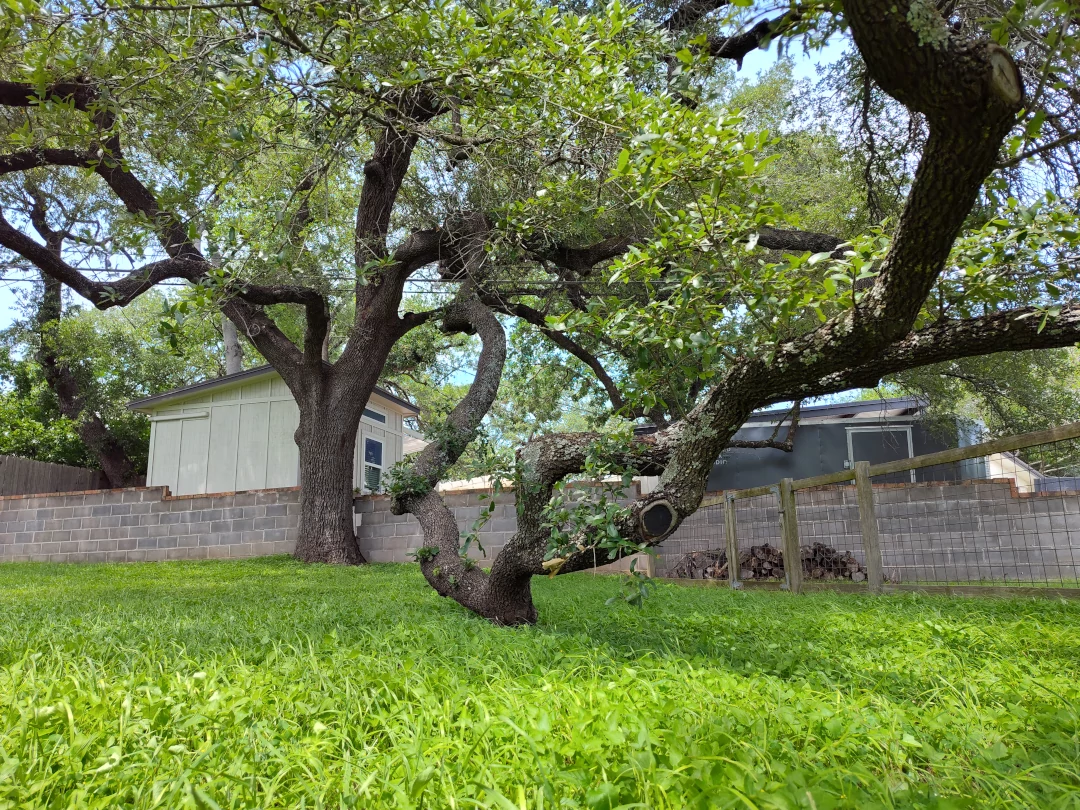The Escarpment Live Oak: A Central Texas Icon

Here in the heart of Texas, few trees are as beloved or iconic as the Escarpment Live Oak (Quercus fusiformis). Its sprawling branches, offering shade and character to our landscapes, have witnessed centuries of history. Let's delve into the fascinating world of this native tree, explore its care, common issues, companion plants, and the rich history it holds.
What's in the name?
The Escarpment Live Oak, a quintessential Texan tree, is scientifically known as Quercus fusiformis. This name reflects its unique acorn shape – "fusiformis" meaning spindle-shaped. This species is sometimes considered a variety of the more coastal Quercus virginiana (Southern Live Oak). In the realm of common names, it's sometimes called Plateau Live Oak, Plateau Oak, or Texas Live Oak, reflecting its wide distribution across the central Texas landscape. This abundance of names speaks to the tree's ubiquity and significance in the region.
Identification
While the Escarpment Live Oak (Quercus fusiformis) often shares similarities with its coastal cousin, the Southern Live Oak, there are key differences to aid identification. Most noticeably, its leaves are generally smaller and less leathery, with a duller sheen compared to the glossy foliage of the Southern Live Oak. The acorns are another distinguishing feature, being more elongated and spindle-shaped, as reflected in the species name fusiformis. Additionally, the bark of the Escarpment Live Oak tends to be darker and more furrowed than that of the Southern Live Oak. Often multi-trunked, this sturdy oak forms dense thickets in its preferred habitat of rocky slopes and canyons. However, due to frequent hybridization with the Southern Live Oak, identifying pure specimens can be tricky, and consulting an arborist may be necessary for accurate identification.
A Tree of Character
The Escarpment Live Oak is a resilient evergreen known for its wide, spreading canopy and gnarled branches. It thrives in the rocky, well-drained soils of the Texas Hill Country and can withstand drought and extreme temperatures.
Basic Maintenance for Your Escarpment Live Oak
- Watering: While drought-tolerant, young trees benefit from regular watering during establishment. Once mature, water deeply during extended dry periods.
- Mulching: A 2-3 inch layer of organic mulch helps retain soil moisture, suppress weeds, and moderate soil temperature.
- Pruning: Escarpment Live Oaks require minimal pruning. Focus on removing dead or diseased branches and maintaining structural integrity. Avoid pruning February 1 to June 30 to minimize the risk of oak wilt infection, and ensure that pruning equipment is properly sanitized.
- Fertilization: Generally not necessary for established trees. A soil test can determine if nutrient deficiencies need to be addressed.
Common Problems & Solutions
The Escarpment Oak is hardy, generally problem free, but here are a few potential issues to look for.
- Oak Wilt: This fungal disease is a serious threat to oaks. Early detection and treatment with fungicide injections are crucial. Watch for sudden leaf drop, discoloration, and fungal mats under the bark.
- Hypoxylon Canker: This fungal disease attacks stressed trees. Maintain tree health through proper care and watering to prevent infection.
- Insect Pests: Escarpment Live Oaks can be affected by various insects like oak gall wasps and scale. Monitor for infestations and consult an arborist for treatment options.
- Root Rot: Typically found in over irrigated areas, this problem can be mitigated by reducing irrigation, and modifying the soil and possibly grade to improve drainage.
Compatible Understory & Groundcover
The dappled shade beneath an Escarpment Live Oak provides an excellent opportunity for creating a beautiful understory. Consider planting native Texas species like:
- Shrubs: Texas mountain laurel, evergreen sumac, yaupon holly
- Perennials: Turk's cap, coral honeysuckle, American beautyberry
- Groundcovers: Pigeonberry, horseherb, cedar sage
The History of the Escarpment Live Oak
These majestic trees have witnessed centuries of history, serving as landmarks for European settlers and indigenous people. Their wood was used for building materials, tools, and even food (acorns were ground into flour by some Native American tribes).
Quercus Fusiformis was first named in 1903 by American botanist John Kunkel Small on page 353 of his book Flora of the southeastern United States. Small specifically notes Q. Fusiformis being found on the arid limestone and granite hills of Central Texas.
There are multiple instances of the majestic Escarpment Live Oak serving as landmarks such as the Treaty Oak, and the Half Way Oak. These remarkable trees have served us for hundreds of years and have stood by us through the test of time.
Treaty Live Oak
The Treaty Live Oak in downtown Austin, Texas, holds a cherished place in the city's history and folklore. Legend holds that it was one of the Council Oaks, a sacred meeting ground for Comanche and Tonkawa tribes before European settlement. While the historical accuracy of the "treaty" story is debated, the tree's cultural significance is undeniable. In the 1920s, it became a symbol of Austin's heritage and narrowly escaped destruction due to development. Today, the Treaty Oak stands as a beloved monument, a testament to the area's rich past, and a living reminder of the importance of preserving our natural heritage.
Famous Trees Of Texas - Treaty Live Oak
Half Way Oak
The Half Way Oak, a majestic live oak in Stephens County, Texas, earned its name as a midway rest stop on the 19th-century stagecoach route between Breckenridge and Cisco. Its sprawling branches offered respite from the harsh Texas sun and shelter from the elements for weary travelers, including, as legend has it, figures like Doc Holliday and Wyatt Earp. Now recognized as a Famous Tree of Texas, the Half Way Oak stands as a living testament to the state's rugged past and the enduring spirit of its natural landmarks.
Texas Historic Tree Coalition - Half Way Oak
ALCO Home & Commercial: Your Tree Care Partner
Whether you're a homeowner lucky enough to have an Escarpment Live Oak gracing your property or considering planting one, ALCO Home & Commercial is here to help. Our staff can offer guidance on tree care, health assessments, and preservation strategies. Let's work together to keep these iconic trees thriving for generations to come!
